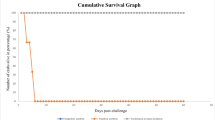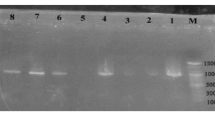Abstract
Viral nervous necrosis (VNN) has emerged to become a major problem in the culture of larval and juvenile marine fish worldwide. Bioactive phytochemicals isolated from commonly available medicinal plants are often screened for their efficacy in controlling fish viral diseases. Occurrence of newer viral strains and resistance to existing antiviral drugs are problems currently associated with treatment of VNN, which necessitates looking for alternate sources for effective antiviral drugs. The aim of the present study was to screen antiviral potential of gymnemagenol (C30H50O4) previously extracted from leaves of Gymnema sylvestre. The fish nodavirus, grouper nervous necrosis virus (GNNV) in infected Sahul Indian Grouper Eye (SIGE) cell lines were used to study the antiviral activity of gymnemagenol under in vitro conditions. The susceptibility of the virus to gymnemagenol was confirmed by measuring the viral titre (TCID50 mL−1) in virus-infected SIGE cells every 24 h. Gymnemagenol at 20 μg mL−1 inhibited the proliferation of GNNV to 53% at the end of the 6th d by inhibiting the proliferation of GNNV-infected SIGE cells. The viable SIGE cells were reduced to 47% as determined by 3-(4, 5-Dimethylthiazol-2-yl)-2, 5-diphenyltetrazolium bromide (MTT) assay. The viral titre (TCID50 mL−1) was also reduced to log 2.8 at the end of the 7th d in gymnemagenol-treated SIGE cells after inoculated with GNNV when compared to untreated control SIGE cell viral titre (log 4.1). Based on our results it can be concluded that gymnemagenol could be used as an antiviral agent against GNNV infection.
Similar content being viewed by others
References
Balasubramanian, G., Sarathia, M., Venkatesan, C., Thomas, J., and Sahul Hameed, A. S., 2008. Oral administration of antiviral plant extract of Cynodon dactylon on a large scale production against white spot syndrome virus (WSSV) in Penaeus monodon. Aquaculture, 279: 2–5.
Chia, T. J., Wu, Y. C., Chen, J. Y., and Chi, S. C., 2010. Antimicrobial peptides (AMP) with antiviral activity against fish nodavirus. Fish and Shellfish Immunology, 28: 434–439.
Chwalek, M., Lalun, N., Bobichon, H., Plé, K., and Voutquenne-Nazabadioko, L., 2006. Structure-activity relationships of some hederagenin diglycosides: haemolysis, cytotoxicity and apoptosis induction. Biochimica et Biophysica Acta, 1760: 1418–1427.
Daisy, P., Eliza, J., and Mohamed Farook, K. A. M., 2009. A novel dihydroxy gymnemic triacetate isolated from Gymnema sylvestre possessing normoglycemic and hypolipidemic activity on STZ-induced diabetic rats. Journal of Ethnopharmacology, 126: 339–344.
Direkbusarakom, S., Herunsalee, A., Yoshimizu, M., Ezura, Y., and Kimura, T., 1997. Efficacy of guava (Psidium guajava) extracts against some fish and shrimp pathogenic agents. In: Diseases in Asian Aquaculture III. Fish Health Section. Flegel, T. W. and MacRae, I. H. (eds.), Asian Fisheries Society, Manila, Philippines, 359–363.
Edwards, P., Little, D. C., and Demaine, H., 2002. Rural Aquaculture, CABI Publishing, Wallingford, Oxon, UK, 1–58.
Francis, G., Makkar, H. P. S., and Becker, K., 2001. Effects of Quillaja saponins on growth, metabolism, egg production, and muscle cholesterol in individually reared Nile tilapia (Oreochromis niloticus). Comparative Biochemistry and Physiology Part C: Toxicology and Pharmacology, 129: 105–114.
Francis, G., Makkar, H. P. S., and Becker, K., 2002. Dietary supplementation with a Quillaja saponin mixture improves growth performance and metabolic efficiency in common carp (Cyprinus carpio L). Aquaculture, 203: 311–320.
Fryer, J. L. and Lannan, C. N., 1994. Three decades of fish cell culture: a current listing of cell lines derived from fish. Journal of Tissue Culture Methods, 16: 87–94.
Gilbert, C., Bestman-Smith, J., and Boivin, G., 2002. Resistance of herpesviruses to antiviral drugs: clinical impacts and molecular mechanisms. Drug Resistance Updates, 5: 88–114.
Hamilton, M. A., Russo, R. C., and Thurston, R. V., 1977. Trimmed Spearman-Karber method for estimating median lethal concentrations in toxicity bioassays. Environmental Science and Technology, 11: 714–719.
Hong, Y., Chen, S. L., Gui, J. F., and Schartl, M., 2004. Retention of the developmental pluriopotency in medaka embryonic stem cells after gene transfer and long-term drug selection towards for gene targeting in fish. Transgenic Research, 13: 41–50.
Jassim, S. A. A. and Naji, M. A., 2003. Novel antiviral agents from plants. Journal of Applied Microbiology, 95: 412–427.
Kannabiran, K., Gopiesh Khanna, V., and Sahul Hameed, A. S., 2010. Antiviral activity of Dasyscyphin C extracted from Eclipta prostrata against fish nodavirus. Journal of Antiviral and Antiretrovirals, 2: 29–32.
Gopiesh khanna, V. and Kannabiran, K., 2008. Antimicrobial activity of saponin fractions of the leaves of Gymnema sylvestre and Eclipta prostrata. World Journal of Microbiology and Biotechnology, 24: 2737–2740.
Gopiesh khanna, V. and Kannabiran, K., 2009. Anticancer-cytotoxic activity of saponin fractions of the leaves of Gymnema sylvestre and Eclipta prostrata on HeLa cells. International Journal of Green Pharmacy, 3: 227–229.
Gopiesh khanna, V., Kannabiran, K., and Getti, G., 2009. Leishmanicidal activity of saponins isolated from the leaves of Eclipta prostrata and Gymnema sylvestre. Indian Journal of Pharmacology, 41: 32–35.
Gopiesh khanna, V., Kannabiran, K., Rajakumar, G., Abdul Rahman, A., and Santhoskumar, T., 2011. Biolarvicidal compound gymnemagenol isolated from leaf extract of miracle fruit plant, Gymnema sylvestre (Retz) Schult against malaria and filariasis vectors. Parasitology Research, (DOI: 10.1007/s00436-011-2384-6).
Kokate, C. K., Purohit, A. P., and Gokhale, S. B., 2006. Pharmacognosy, Nirali Prakashan, Pune, India, 246–252.
Kuo, H. C., Wang, T. Y., Chen, P. P., Chen, Y. M., Chuang, H. C., and Chen, T. Y., 2011. Real-time quantitative PCR assay for monitoring of nervous necrosis virus infection in grouper aquaculture. Journal of Clinical Microbiology, 49: 1090–1096.
Kurokawa, M., Ohyama, H., Hogumi, T., Namba, T., Nakano, M., and Shiraki, K., 1996. Assay for antiviral activity of herbal extracts using their absorbed sera. Chemical and Pharmaceutical Bulletin, 44: 1270–1272.
Liu, H. M., Kiuchi, F., and Tsuda, Y., 1992. Isolation and structure elucidation of gymnemic acids, antisweet principles of Gymnema sylvestre. Chemical and Pharmaceutical Bulletin, 40: 1366–1375.
Liu, J., 1995. Pharmacology of oleanic acid and ursolic acid. Journal of Ethanopharmacology, 49: 57–68.
Liu, J. and Henkel, T., 2002. Traditional Chinese Medicine (TCM): Are polyphenols and saponins and key ingredients triggering biological activities? Current Medicinal Chemistry, 9: 1483–1485.
Munday, B. L., Kwang, J., and Moody, N., 2002. Betanodavirus infection of teleost fish: a review. Journal of Fish Diseases, 25: 127–142.
Notomi, T., Okayama, H., Masubuchi, H., Yonekawa, T., Watanabe, K., Amino, N., and Hase, T., 2000. Loop-mediated isothermal amplification of DNA. Nucleic Acids Research, 28: e63.
Parameswaran, V., Ishaq Ahmed, V. P., Shukla, R., Bhonde, R. R., and Sahul Hameed, A. S., 2007. Development and Characterization of Two New Cell Lines from Milkfish (Chanos chanos) and Grouper (Epinephelus coioides) for Virus Isolation. Marine Biotechnology, 9: 281–291.
Peng, Y., Zheng, J., Huang, R., Wang, Y., Xu, T., Zhou, X., Liu, Q., Zeng, F., Ju, H., Yang, X., and Liu, Y., 2010. Polyhydroxy steroids and saponins from China Sea starfish Asterina pectinifera and their biological activities. Chemical and Pharmaceutical Bulletin, 58: 856–858.
Reed, L. J. and Muench, H., 1938. A simple method of estimating fifty percent end-points. American Journal of Hygiene, 27: 493–497.
Roner, M. R., Tam, K. I., and Kiesling-Barrager, M., 2010. Prevention of rotavirus infections in vitro with aqueous extracts of Quillaja Saponaria Molina. Future Medicinal Chemistry, 2: 1083–1097.
Sahu, N. P., Mahato, S. B., Sarkar, S. K., and Poddar, G., 1996. Triterpenoid saponins from Gymnema sylvestre. Phytochemistry, 41: 1181–1185.
Sahul Hameed, A. S., Yoganandhan, K., Sri Widada, J., and Bonami, J. R., 2004. Studies on the occurrence and RT-PCR detection of Macrobrachium rosenbergii nodavirus (MrNV) and extra small virus like particles (XSV) associated with white tail disease (WTD) of Macrobrachium rosenbergii in India. Aquaculture, 238: 127–133.
Sánchez-Paz, A., 2010. White spot syndrome virus: an overview on an emergent concern. Veterinary Research, 41: 43.
Subbarao, G. and Joseph, E. S., 1971. Constituents from Gymnema sylvestre leave VIII: Isolation, chemistry and derivatives of gymnemagenin and gymnestrogenin, Journal of Pharmaceutical Sciences, 60: 190–192.
Sudheer, N. S., Philip, R., and Singh, I. S. B., 2011. In vivo screening of mangrove plants for anti WSSV activity in Penaeus monodon and evaluation of Ceriops tagal as a potential source of antiviral molecules. Aquaculture, 311: 36–41.
Suthindhiran, K., Sarath Babu, V., Kannabiran, K., Ishaq Ahmed, V. P., and Sahul Hameed, A. S., 2011. Anti-fish nodaviral activity of furan-2yl acetate extracted from marine Streptomyces spp. Natural Product Research, 25: 834–843.
Tang, K. F. J., Pantoja, C. R., Redman, R. M., and Lightner, D. V., 2007. Development of in situ hybridization and RT-PCR assay for the detection of a nodavirus (PvNV) that causes muscle necrosis in Penaeus vannamei. Diseases of Aquatic Organisms, 75: 183–190.
Wang, Y. D., Kung, C. W., and Chen, J. Y., 2010. Antiviral activity by fish antimicrobial peptides of epinecidin-1 and hepcidin 1–5 against nervous necrosis virus in medaka. Peptides, 31: 1026–1033.
Ward, J. R. and Lafferty, K. D., 2004. The elusive baseline of marine disease: are diseases in ocean ecosystems increasing? PLoS Biology, 2: 542–547.
Walker, P. J. and Winton, J. R., 2010. Emerging viral diseases of fish and shrimp. Veterinary Research, 41: 51.
Ye, W., Liu, X., Zhang, Q., Che, C., and Zhao, S., 2001. Antisweet saponins from Gymnema sylvestre. Journal of Natural Products, 64: 232–235.
Yogeeswari, P. and Sriram, D., 2005. Beutilinic acid and its derivatives: a review on their biological activities. Current Medicinal Chemistry, 12: 657–666.
Yoshikawa, K., Arihara, S., Matsuura, K., and Miyase, T., 1992. Dammarane saponins from Gymnema sylvestre. Phytochemistry, 31: 237–241.
Author information
Authors and Affiliations
Corresponding author
Rights and permissions
About this article
Cite this article
Gopiesh Khanna, V., Kannabiran, K., Sarath Babu, V. et al. Inhibition of fish nodavirus by gymnemagenol extracted from Gymnema sylvestre . J. Ocean Univ. China 10, 402–408 (2011). https://doi.org/10.1007/s11802-011-1841-2
Received:
Revised:
Accepted:
Published:
Issue Date:
DOI: https://doi.org/10.1007/s11802-011-1841-2




